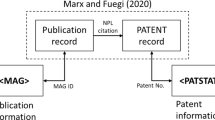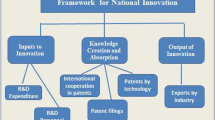Abstract
When quantifying spillover effects among technologies and between science and technology one faces the problem that clear-cut measurement procedures are difficult to define and to validate. The well-known approach by indexing certain outputs (patent documents) grasps only parts of the complex and feedback innovation-oriented processes. However, recently, new promising lines of research for understanding technological externalities have been embarked upon. New measurements of the science-technology-innovation interface are presented from three different aspects. First, the overall properties of technological spillover and, second, of science involvement in innovations are presented on a world-wide scale. The third main section of the results provides a panoramic view of scientific involvement in technology in terms of a country comparison. The contribution attempts to add quantitative evidence for an evolutionary understanding of the externalities between public science, latent public technology and private innovation.
Similar content being viewed by others
References
Archibugi D (1988) The inter-industry distribution of technological capabilities. Technovation 7: 259–274
Arrow KJ (1962) The economic Implication of Learning by Doing. Rev Econ Studies 29:155–173
Bator FM (1958) The anatomy of market failure. Qu J Econ 72:351–379
Cantner U, Hanusch H (1991) New Developments in the Economics of Technology and Innovation. Institut für VWL, Volkswirtschaftliche Diskussionsreihe, Beitrag Nr. 64, Universität Augsburg
Carpenter MP, Cooper M, Narin F (1980) Linkage between Basic Research Literature and Patents. Res Management 13: 30–35
Coward HR, Franklin JJ (1989) Identifying the Science-Technology Interface: Matching Patent Data to a Bibliometric Model. Science Technol Human Values 14: 50–77
Dasgupta PS, David PA (1987) Information Disclosure and the Economics of Science and Technology. In: Feiwel G (ed) Kenneth Arrow and the Ascent of Economic Theory, MacMillan, New York
David PA, Mowery D, Steinmueller WE (1992) Analysing the Economic Payoffs from Basic Research, Econ Innov New Techn 2: 73–90
Dosi G (1988) Sources, procedures and microeconomic effects of innovation, J Econ Literature 26: 1120–71
Dosi G, Freeman C, Nelson R, Silverberg G, Soete L (eds) (1988), Technical Change and Economic Theory. Pinter, London
Dror I (1993) The Process of Technology Evolution. Multitechnology Innovations as the Driving Force. Tech Forecast Soc Change 44: 49–58
Engelsman EC, van Raan AFJ (1991). Mapping of Technology. Report CWTS-91-01, Centre for Science and Technology Studies (CWTS), Leyden
Freeman C (1982) The Economics of Industrial Innovation, 2nd ed. Pinter, London
Freeman C (1984) Prometheus unbound. Futures 16: 494–507
Freeman C, Soete L (1990) Introduction. In: Freeman C, Soete L (eds), Explorations in the Economics of Technical Change. Pinter, London, p viix
Freeman C, Soete L (eds) (1990) Explorations in the Economics of Technical Change. Pinter, London
Gibbons M, Johnston R (1974) The roles of science in technological innovations. Res Policy 3: 220–242
Griliches Z (1991) The Search for R&D Spillovers. Working Paper No. 3768, National Bureau of Economic Research, Cambridge, Mass.
Grupp H (1990) The concept of Entropy in Scientometrics and Innovation Research. Scientometrics 18: 219–239
Grupp H (1991) Innovation Dynamics in OECD Countries: Towards a Correlated Network of R&D. Intensity, Trade, Patent and Technometric Indicators. In: OECD (ed.) Technology and Productivity. The Challenge for Economic Policy. OECD, Paris
Grupp H (ed) (1992) Dynamics in Science-Based Innovation. Springer, Berlin Heidelberg New York
Grupp H (1993) Dynamics of Science-Based Innovation in Northern America, Japan and Western Europe. In: Okamura S, Sakauchi F, Nonaka I (eds) Science and Technology Policy Research: New Perspectives on Global Science and Technology Policy. Mita Press, Tokyo, pp 179–194
Grupp H (1994) The dynamics of Science-Based Innovation Reconsidered: Cognitive Models and Statistical Findings. In: Granstrand O (ed) Economics of Technology. Elsevier, Amsterdam. pp. 223–251
Grupp H, Schmoch U (1992) Wissenschaftsbindung der Technik, Physica, Heidelberg
Grupp H, Schmoch U (1992a) Perception of scientification of innovation as measured by referencing between patents and papers — Dynamics in science-based fields of technology. In: Grupp H (1992) Dynamics in Science-Based Innovation. Springer, Berlin Heidelberg New York, pp 73–128
Hanusch H, Cantner U (1993) Neuere Ansätze in der Innovationstheorie und der Theorie des technischen Wandels — Konsequenzen für eine Industrie- und Technologiepolitik. In: Meyer-Krahmer F (ed) Innovationsökonomie und Technologiepolitik. Schriftenreihe Technik, Wirtschaft und Politik. Physica, Heidelberg, pp 11–46
Harabi N (1993) Technologische Chancen und technischer Fortschritt: Eine empirische Untersuchung. Working paper series D, no. 28 Wirtschaftswissenschaftliches Institut der Universität Zürich
Harhoff D, König H (1993) Neuere Ansätze der Industrieökonomik — Konsequenzen für eine Industrie- und Technologiepolitik. In: Meyer-Krahmer F (ed) Innovationsökonomie und Technologiepolitik. Schriftenreihe Technik, Wirtschaft und Politik. Physica, Heidelberg, pp 47–67
Jaffe AB (1986) Technological Opportunity and Spillovers of R&D: Evidence from Firms' Patents Profits, and Market Value. Am Econ Rev 76: 984–1001
Jaffe AB (1989) Characterizing the “technological position” of firms, with application to quantifying technological opportunity and research spillovers. Res Policy 18: 87–97
Kline SJ, Rosenberg N (1986) An Overview of Innovation. In: Landau R, Rosenberg N (eds) The Positive Sum Strategy. Harnessing Technology for Economic Growth. National Academy Press, Washington, D.C. pp 275–306
Kruskal JB (1964) Multidimensional scaling by optimizing goodness of fit to non-metric hypotheses. Psychometrica 29: 1–27
Legler H, Grupp H, Gehrke B, Schasse U (1992) Innovationspotential und Hochtechnologie. Physica, Heidelberg
Majer H (1978). Industrieforschung in der Bundesrepublik Deutschland. J. C. B. Mohr, Tübingen
Mandelbrot BB (1982) The Fractal Geometry of Nature. Freeman, San Francisco
Mansfield E (1991) Academic research and industrial innovation. Res Policy 20: 1–12
Meyer-Krahmer F (1989) Der Einfluß staatlicher Technologiepolitik auf Innovationen. Nomos, Baden-Baden
Meyer-Krahmer F (ed) (1993) Innovationsökonomie und Technologiepolitik, Schriftenreihe Technik, Wirtschaft und Politik. Physica, Heidelberg
Meyer-Krahmer F, Grupp H (1993) Strategische Sektoren der Bundesrepublik Deutschland — Empirische Befunde und Vermutungen. In: Meyer-Krahmer F (ed) Innovationsökonomie und Technologiepolitik. Schriftenreihe Technik, Wirtschaft und Politik. Physica, Heidelberg pp 247–273
Narin F, Rosen M, Olivastro D (1989) Patent Citation Analysis: New Validation Studies and Linkage Statistics. In: van Raan AFJ, Nederhof AJ, Moed HF (eds) Science and Technology Indicators: Their Use in Science Policy and Their Role in Science Studes. Proceedings, Leiden Workshop on Science and Technology Indicators. DSWO Press, Leiden
Narin F, Noma E (1985) Is Technology becoming Science? Scientometrics 7: 369–381
Nelson R (1988) Institutions supporting technical change in the United States. In: Dosi G, Freeman C, Nelson R, Silverberg G, Soete Z (eds) Technical Change and Economic Theory. Pinter, London, pp 312–329
Nelson RR (1990) What is Public and What is Private about Technology. Working Paper #90-9, University of California at Berkeley
Okamuro S, Sakauchi F, Nonaka I (eds) (1993) Science and Technology Policy Research: New Perspectives on Global Science and Technology Policy. Mita Press, Tokyo
Olivastro D, Narin F (1989) Definition of Fields of Close Cooperation between Science and Technology. Report submitted to BMFT, CHI Research/Computer Horizons, Inc., Haddon Heights
Pavitt K (1984) Sectoral patterns of technical change: towards a taxonomy and a theory. Res Policy 13: 343–373
Rosenberg N (1991) Critical issues in science policy research. Sci Public Policy 18: 335–346
Scherer FM (1982) Inter-Industry technology flows in the United States. Res Policy 11: 227–245
Schmoch U (1990) Wettbewerbsvorsprung durch Patentinformation. Verlag TUEV, Rheinland, Cologne
Silverberg G (1990) Adoption and diffusion of technology as a collective evolutionary process. In: Freeman C, Soete L (eds) Explorations in the Economics of Technical Change. Pinter, London, pp 177–192
Stankiewicz R (1992) Technology as an autonomous socio-cognitive system. In: Grupp H (ed) Dynamics of Science-Based Innovation. Springer, Berlin Heidelberg New York, pp 19–44
van Raan AFJ (1991) Fractal dimensions of co-citations. Nature 347: 626
van Raan AFJ, Nederhof AJ, Moed HF (eds) (1989) Science and Technology Indicators: Their Use in Science Policy and Their Role in Science Studies. Proceedings, Leiden Workshop on Science and Technology Indicators, DSWO-Press, Leiden
van Vianen BG, Moed, HF, van Raan DFJ (1990) An Exploration of the Science Base of Recent Technology. Res Policy 19: 61–81
Walsh V (1984) Invention and innovation in the chemical industry: Demand-pull or discoverypush? Res Policy 13: 211–234
Woeckener B (1993) Innovation, externalities, and the state: a synergetic approach, J Evol Econ 3: 225–248
Author information
Authors and Affiliations
Rights and permissions
About this article
Cite this article
Grupp, H. Spillover effects and the science base of innovations reconsidered: an empirical approach. J Evol Econ 6, 175–197 (1996). https://doi.org/10.1007/BF01202593
Issue Date:
DOI: https://doi.org/10.1007/BF01202593
Key words
- Science-based industry
- Spillover
- Technological externalities
- Innovation measurement
- Technological innovation
- Patent statistics
- Technology indicators




